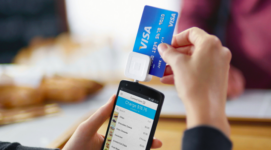Payment methods are changing. A decade ago, no one would have thought that digital currencies would be a viable payment option. Phones that pay for goods with a simple swipe would be a complete shock just 15 years ago.
People are paying for goods differently than ever before, and it’s up to small business owners to stay on top of these trends.
You don’t want to turn away a potential customer.
New technologies that are changing the way we pay include:
1. EMV Cards
EMV cards, or chip cards, are starting to pop up in stores across the world. These cards use a small built-in chip that’s inserted into a reader. Sure, you’ll still be using a credit card, but EMV readers add an extra layer of security that makes consumers sleep better at night knowing their identity is safe.
Magnetic-stripe cards are vulnerable to fraud.
EMV cards are the future of credit cards, and most merchant accounts now offer this new technology. You’ll still be accepting money or credit from the same banks and lenders, but your customers’ identities will remain safe – a key part of any business’s reputation.
2. Apple, Google and Samsung Pay
Mobile wallets are all the rage. Consumers are flocking to the likes of Apple Pay, Google Pay and Samsung Pay, which all use a technology called near-field communication (NFC). The technology allows your mobile device to communicate with a payment reader.
Wireless communication and encryption allow these devices to communicate, and it eliminates the burden of needing to carry a wallet around with you all the time.
NFC technology is also much faster than EMV technology, taking just seconds for the process to complete.
There are a lot of digital wallet options available, and small businesses that accept this new form of payment will find that tech-savvy consumers will appreciate the added security and service. There are quite a few additional wallets available aside from the big three mentioned above, so take your time researching your merchant account and find a solution that works best for your customers.
3.Online Payment Acceptance
Businesses must accept online payments. Even if you don’t conduct business online right now, you might in the future. You need to be able to accept payments online, send invoices and keep track of billings. And when you accept payments online, there’s a lot to consider, such as:
· Digital currencies
· Bank transfers
· PayPal, Stripe, etc
· Credit and debit
There are also a lot of e-commerce solutions to consider, such as WooCommerce.
You have a lot of payment gateways that will connect into your e-commerce solutions, allowing for a wider range of flexibility than using just PayPal, including: Authorize.net, Dwolla, WePay, ACH Payments and dozens of others.
The idea is to accept most payment sources for your clients.
You may also accept payment via invoice, which can be done through PayPal, or it can be done through something a little more complex, such as: Invoicely, PaySimple, WaveApps and so on. The great thing about invoices is that it allows larger clients to pay on Net 30, 60, 90 or any arrangement you have in place.
It’s all about flexibility for your customers, whether they buy items in-store or online.








